Septic Systems
Smoke Testing :: Exterior Smoke Testing
Before Smoke testing can take place local police
and fire agencies must be notified, as well as any potential
residential or industrial connections to the line being tested.
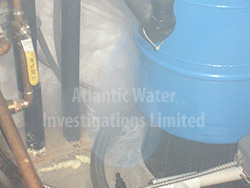 Exterior smoke testing is best used to detect: Exterior smoke testing is best used to detect:
- Inflow sources such as storm sewer inter-connections
- Point source inflow
leaks in drainage paths or ponding areas
- Roof leaders
- Area drains
- Foundation drains
- Abandoned building sewer laterals
Exterior smoke testing is known to be a
relatively inexpensive and quick method of detecting
inflow/infiltration sources in sewer systems. Using a gas driven
fan, a safe and non toxic petroleum distillate (liquid smoke) is
forced into the storm or sanitary sewer system. Lighter than air
liquid smoke passes through the storm or sanitary system and rises
through any openings that exist within the system. Smoke testing is
the most cost effective and efficient way to locate infiltration and
exfiltration problems in sewer systems. It is used to find leaks,
inflow sources and most restrictive conditions within the sewer
lines. Smoke testing helps identify plumbing problems or leaks in
buildings. Sewer gases can cause health problems for occupants.
Smoke testing is also an extremely good method for tracking piping
systems and other mapping purposes. The system configuration is also
proven by locating hidden manholes and identifying any new
construction that has not been updated on drawings.
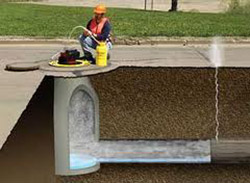 Smoke testing involves forcing smoke-filled air
through a sewer line and into the sewer system. The smoke under
pressure will fill the main line plus any connection lines or leaks.
The smoke is non-toxic and only enough force to overcome atmospheric
pressure is required to adequately fill the system, thus forcing the
smoke through any connecting lines, and will come out at any
opening. As long as openings exist for the smoke to flow, smoke
tests are effective, regardless of surface characteristics, soil
make-up and depth of sewer lines. Whether in a municipal mainline
sewer, residential or industrial system, breaks or illegal taps in
the sewer line will allow the smoke to escape and surface through
the ground or pipe work quickly revealing the source of the problem.
Smoke testing can be used for locating illegal connections, cross
connections or leaks in a sealed system. Illegal or improper cross
connections can add up to trouble in sanitary or storm sewers. Leaks
can be found using smoke testing simply by filling the pipeline with
smoke, for long enough, that the smoke saturates the ground and
comes to the surface. As long as openings exist for the smoke to
follow, smoke tests are effective, regardless of surface type, soil
type and depth of the lines. Smoke testing involves forcing smoke-filled air
through a sewer line and into the sewer system. The smoke under
pressure will fill the main line plus any connection lines or leaks.
The smoke is non-toxic and only enough force to overcome atmospheric
pressure is required to adequately fill the system, thus forcing the
smoke through any connecting lines, and will come out at any
opening. As long as openings exist for the smoke to flow, smoke
tests are effective, regardless of surface characteristics, soil
make-up and depth of sewer lines. Whether in a municipal mainline
sewer, residential or industrial system, breaks or illegal taps in
the sewer line will allow the smoke to escape and surface through
the ground or pipe work quickly revealing the source of the problem.
Smoke testing can be used for locating illegal connections, cross
connections or leaks in a sealed system. Illegal or improper cross
connections can add up to trouble in sanitary or storm sewers. Leaks
can be found using smoke testing simply by filling the pipeline with
smoke, for long enough, that the smoke saturates the ground and
comes to the surface. As long as openings exist for the smoke to
follow, smoke tests are effective, regardless of surface type, soil
type and depth of the lines.
Exterior Smoke Testing Smoke Blower Leak
Detection Test of Sanitary Municipal Sewer Lines
Smoke testing sewer systems was introduced in the
early 1960's as a method of identifying areas where extraneous water
was entering sanitary sewer systems. Today, smoke testing is known
to be a proven method of effectively identifying inflow
(storm/ground water entry into sanitary sewer), connected roof and
basement drains, yard drains, illegal taps, and storm sewer cross
connections.
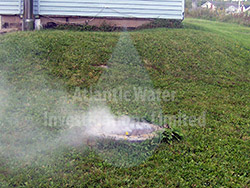 Atlantic Water Investigations Limited offers
smoke testing, an extremely tangible process in which storm water
cross connections are visual immediately upon testing. Although the
concept is simple, it takes careful planning and an experienced firm
in order to implement a successful smoke testing program. The result
is a visual confirmation of smoke in a storm water system, evidence
that rain water has been entering the sanitary sewer system. Safe,
non-toxic smoke is generated and blown into sanitary sewer systems
under very low pressure. The smoke will enter the sanitary system as
well as cross connected storm water sources such as roof leaders and
perimeter drains. Reducing inflow and infiltration saves costs from
treating groundwater at wastewater treatment plants. The
Environmental Protection Agency has instructed municipalities to
eliminate inflow and infiltration into sewer systems. Smoke testing
sewer systems is an effective way to accomplish this goal. Atlantic Water Investigations Limited offers
smoke testing, an extremely tangible process in which storm water
cross connections are visual immediately upon testing. Although the
concept is simple, it takes careful planning and an experienced firm
in order to implement a successful smoke testing program. The result
is a visual confirmation of smoke in a storm water system, evidence
that rain water has been entering the sanitary sewer system. Safe,
non-toxic smoke is generated and blown into sanitary sewer systems
under very low pressure. The smoke will enter the sanitary system as
well as cross connected storm water sources such as roof leaders and
perimeter drains. Reducing inflow and infiltration saves costs from
treating groundwater at wastewater treatment plants. The
Environmental Protection Agency has instructed municipalities to
eliminate inflow and infiltration into sewer systems. Smoke testing
sewer systems is an effective way to accomplish this goal.
Smoke testing is accomplished by isolating a
section of sewer line and introducing smoke into the line utilizing
a smoke blower and smoke-generating device. (Important: Notify all
local authorities and citizens before conducting smoke tests! Cherne
provides guidelines for properly preparing and announcing to the
community that a smoke test will be conducted.) Client responsible
to isolate lines with pipe plugs if required before test. Lines
plugged before testing can fill up with sewer and have the
probability of sewer backup flooding residences. We conduct the test
without plugging up the lines. Then smoke is introduced into the
sewer system. The clients test crew then checks buildings, roof
vents, the street, and other areas that potentially could be a
source of extraneous water and records those locations for
corrective follow-up.
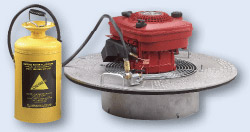 Our smoke blower is available for either
traditional "smoke bombs" or liquid smoke fluid. Available with a
5.5 horsepower Honda engine, our unit generates up to 3769 cubic
feet per minute of airflow to quickly introduce smoke into the sewer
system. Cherne's blowers are made of lightweight cast aluminum and
feature a 1/2" foam cell gasket to insure a leak-free seal on
manholes and minimize vibration. The traditional smoke blower has a
smoke bomb box holder, whereas the liquid smoke blower is supplied
with a pressurized tank, hose and all components necessary to
conduct the smoke test. Our smoke blower is available for either
traditional "smoke bombs" or liquid smoke fluid. Available with a
5.5 horsepower Honda engine, our unit generates up to 3769 cubic
feet per minute of airflow to quickly introduce smoke into the sewer
system. Cherne's blowers are made of lightweight cast aluminum and
feature a 1/2" foam cell gasket to insure a leak-free seal on
manholes and minimize vibration. The traditional smoke blower has a
smoke bomb box holder, whereas the liquid smoke blower is supplied
with a pressurized tank, hose and all components necessary to
conduct the smoke test.
|
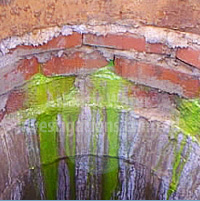


 Exterior smoke testing is best used to detect:
Exterior smoke testing is best used to detect: Smoke testing involves forcing smoke-filled air
through a sewer line and into the sewer system. The smoke under
pressure will fill the main line plus any connection lines or leaks.
The smoke is non-toxic and only enough force to overcome atmospheric
pressure is required to adequately fill the system, thus forcing the
smoke through any connecting lines, and will come out at any
opening. As long as openings exist for the smoke to flow, smoke
tests are effective, regardless of surface characteristics, soil
make-up and depth of sewer lines. Whether in a municipal mainline
sewer, residential or industrial system, breaks or illegal taps in
the sewer line will allow the smoke to escape and surface through
the ground or pipe work quickly revealing the source of the problem.
Smoke testing can be used for locating illegal connections, cross
connections or leaks in a sealed system. Illegal or improper cross
connections can add up to trouble in sanitary or storm sewers. Leaks
can be found using smoke testing simply by filling the pipeline with
smoke, for long enough, that the smoke saturates the ground and
comes to the surface. As long as openings exist for the smoke to
follow, smoke tests are effective, regardless of surface type, soil
type and depth of the lines.
Smoke testing involves forcing smoke-filled air
through a sewer line and into the sewer system. The smoke under
pressure will fill the main line plus any connection lines or leaks.
The smoke is non-toxic and only enough force to overcome atmospheric
pressure is required to adequately fill the system, thus forcing the
smoke through any connecting lines, and will come out at any
opening. As long as openings exist for the smoke to flow, smoke
tests are effective, regardless of surface characteristics, soil
make-up and depth of sewer lines. Whether in a municipal mainline
sewer, residential or industrial system, breaks or illegal taps in
the sewer line will allow the smoke to escape and surface through
the ground or pipe work quickly revealing the source of the problem.
Smoke testing can be used for locating illegal connections, cross
connections or leaks in a sealed system. Illegal or improper cross
connections can add up to trouble in sanitary or storm sewers. Leaks
can be found using smoke testing simply by filling the pipeline with
smoke, for long enough, that the smoke saturates the ground and
comes to the surface. As long as openings exist for the smoke to
follow, smoke tests are effective, regardless of surface type, soil
type and depth of the lines. Atlantic Water Investigations Limited offers
smoke testing, an extremely tangible process in which storm water
cross connections are visual immediately upon testing. Although the
concept is simple, it takes careful planning and an experienced firm
in order to implement a successful smoke testing program. The result
is a visual confirmation of smoke in a storm water system, evidence
that rain water has been entering the sanitary sewer system. Safe,
non-toxic smoke is generated and blown into sanitary sewer systems
under very low pressure. The smoke will enter the sanitary system as
well as cross connected storm water sources such as roof leaders and
perimeter drains. Reducing inflow and infiltration saves costs from
treating groundwater at wastewater treatment plants. The
Environmental Protection Agency has instructed municipalities to
eliminate inflow and infiltration into sewer systems. Smoke testing
sewer systems is an effective way to accomplish this goal.
Atlantic Water Investigations Limited offers
smoke testing, an extremely tangible process in which storm water
cross connections are visual immediately upon testing. Although the
concept is simple, it takes careful planning and an experienced firm
in order to implement a successful smoke testing program. The result
is a visual confirmation of smoke in a storm water system, evidence
that rain water has been entering the sanitary sewer system. Safe,
non-toxic smoke is generated and blown into sanitary sewer systems
under very low pressure. The smoke will enter the sanitary system as
well as cross connected storm water sources such as roof leaders and
perimeter drains. Reducing inflow and infiltration saves costs from
treating groundwater at wastewater treatment plants. The
Environmental Protection Agency has instructed municipalities to
eliminate inflow and infiltration into sewer systems. Smoke testing
sewer systems is an effective way to accomplish this goal. Our smoke blower is available for either
traditional "smoke bombs" or liquid smoke fluid. Available with a
5.5 horsepower Honda engine, our unit generates up to 3769 cubic
feet per minute of airflow to quickly introduce smoke into the sewer
system. Cherne's blowers are made of lightweight cast aluminum and
feature a 1/2" foam cell gasket to insure a leak-free seal on
manholes and minimize vibration. The traditional smoke blower has a
smoke bomb box holder, whereas the liquid smoke blower is supplied
with a pressurized tank, hose and all components necessary to
conduct the smoke test.
Our smoke blower is available for either
traditional "smoke bombs" or liquid smoke fluid. Available with a
5.5 horsepower Honda engine, our unit generates up to 3769 cubic
feet per minute of airflow to quickly introduce smoke into the sewer
system. Cherne's blowers are made of lightweight cast aluminum and
feature a 1/2" foam cell gasket to insure a leak-free seal on
manholes and minimize vibration. The traditional smoke blower has a
smoke bomb box holder, whereas the liquid smoke blower is supplied
with a pressurized tank, hose and all components necessary to
conduct the smoke test.